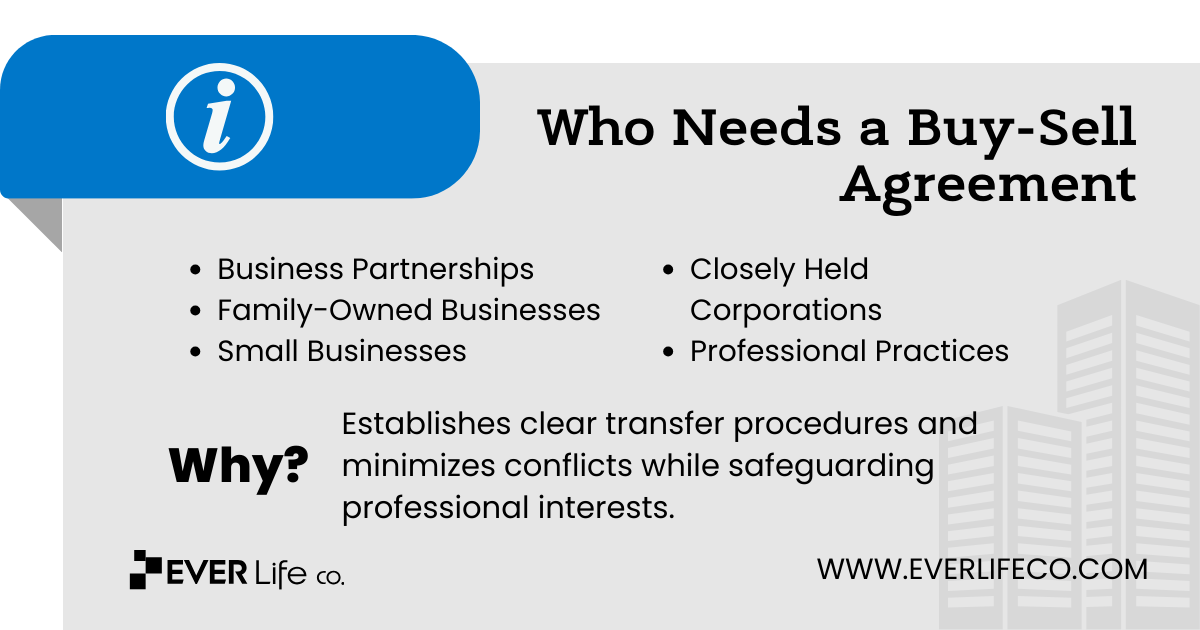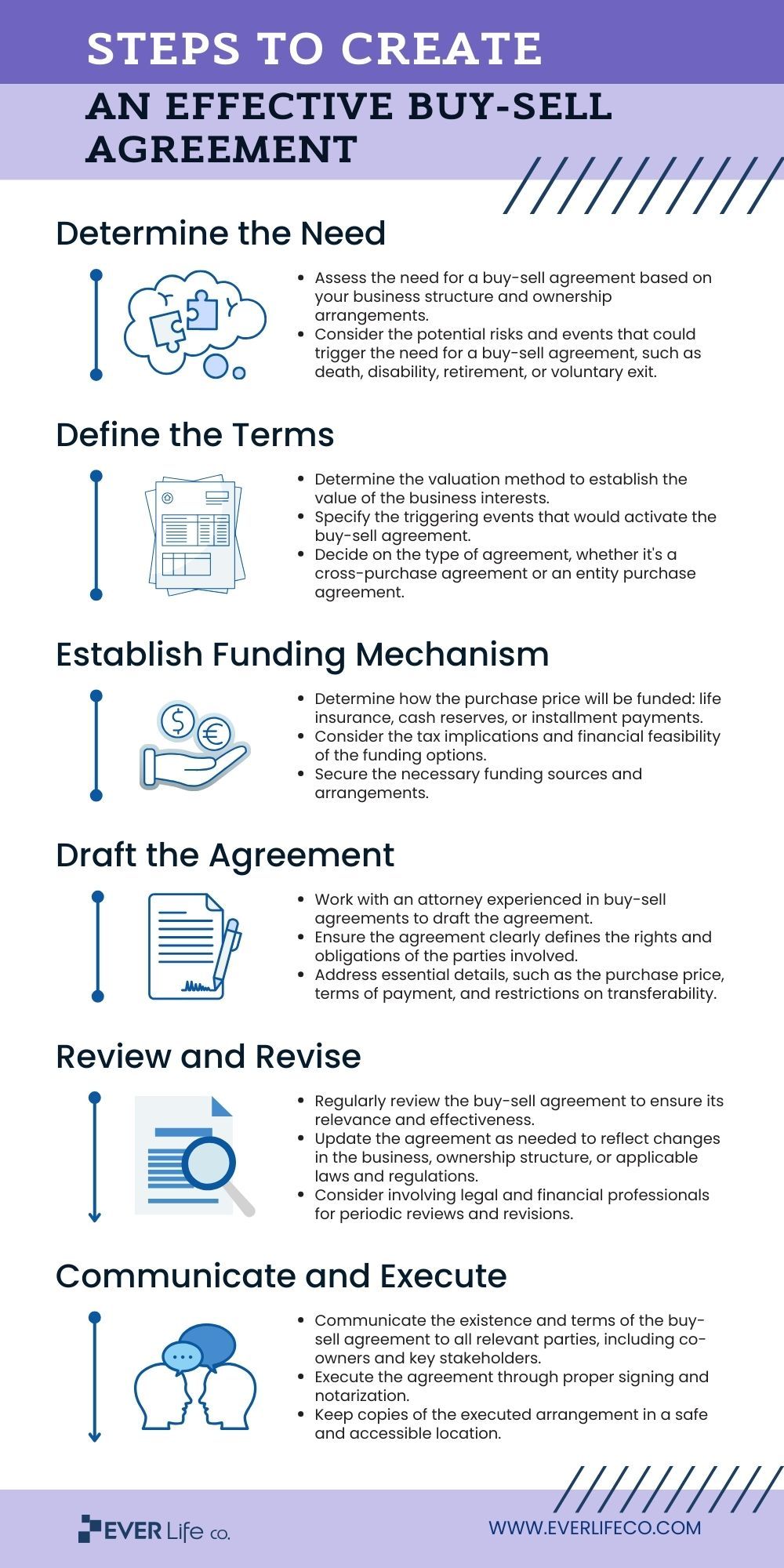If you’re a business owner, ensuring a smooth transition of power and protecting the interests of all stakeholders is paramount. Buy-sell agreements are vital tools for business owners to achieve this.
Whether you’re a seasoned entrepreneur or embarking on a new venture, understanding buy-sell agreements is crucial to safeguarding your business’s continuity and stability.
This comprehensive guide will delve into buy-sell agreements, shedding light on their significance, functionality, and how they can shield businesses from potential disputes and setbacks.
What is a Buy-Sell Agreement?
When you have a business, it’s essential to have a plan in place for the orderly transfer of ownership in the event of the death, disability, or employment termination of a co-owner. This is where a buy-sell arrangement comes in handy.
Definition and Purpose of Buy-Sell Agreements
At its core, a buy-sell agreement is a legal document that stipulates the terms and conditions for the sale or transfer of ownership interest in a business. It serves as a proactive measure to address potential ownership changes, establishes a framework for smooth transitions, and mitigates shareholder disputes.
As a guideline, buy-sell arrangements outline how to handle the business share of a deceased partner or departing owner. It typically sets forth the terms of a potential buyout of shares, including the purchase price and payment terms.
A well-crafted buy-sell deal is an effective continuity and business succession planning tool. It offers clarity and structure, ensuring all parties understand their rights, obligations, and limitations after a trigger event.
Types of Buy-Sell Agreements
There are various types of buy-sell agreements, each designed to cater to different ownership structures and objectives. The three most common styles are:
- Cross-Purchase Agreements: In this arrangement, individual owners agree to purchase the ownership interest of a departing owner. Each owner holds a separate deal with every other owner, allowing for a personalized approach.
- Entity or Redemption Agreements: Unlike cross-purchase agreements, the business entity agrees to repurchase the ownership interest of a departing owner. The remaining owners acquire the redeemed stock, resulting in a reallocation of ownership. About 80 to 85 percent of arrangements are entity purchases. [Source]
- Hybrid Agreements: As the name suggests, hybrid agreements combine elements of both cross-purchase and redemption agreements. They offer flexibility by allowing specific owners to purchase the departing owner’s interest while the entity redeems the remaining shares.
Common Trigger Events for Buy-Sell Agreements
The triggers for the enforcement of a buy-sell agreement are specific events that impact the ownership structure or continuity of the business. These events may include:
- Death: The deal outlines the procedures for handling the ownership interest of a deceased owner, ensuring a smooth buyout of owner shares, and providing financial security for their family.
- Permanent Disability: If an owner becomes permanently disabled and can no longer actively participate in the company, the buy-sell arrangement addresses the terms for transferring their business assets.
- Retirement: When an owner decides to retire, the arrangement stipulates the conditions for selling their interest and facilitating a seamless business succession plan.
- Divorce: In the event of a divorce, the noted provisions address the assignment of shares between the divorcing parties and the remaining company shareholders.
- Voluntary Exit: An owner may choose voluntary termination of employment for personal reasons or career changes. The buy-sell agreement outlines the process and terms for selling their ownership interest.
Key Stakeholders Involved in a Buy-Sell Agreement
Several parties play critical roles in the execution of a buy-sell agreement:
- Business Owners: The individuals with ownership interests in the business are parties to the agreement. They may be required to buy or sell their interests according to the deal’s provisions.
- Business Entity: The legal structure of the business, whether it is a corporation, partnership, or limited liability company (LLC). The entity may have an obligation to redeem shares or facilitate the transfer of company ownership as per the legal agreements signed.
- Attorneys and Advisors: Legal professionals specializing in business law, as well as financial advisors and valuation experts, play a crucial role in drafting, reviewing, and ensuring the enforceability of the buy-sell arrangement.
Who Needs a Buy-Sell Agreement
Various types of businesses can significantly benefit from implementing buy-sell agreements, including:
- Business Partnerships: In partnerships and businesses with multiple owners, a buy-sell arrangement is necessary to address ownership changes and protect the interests of the individual partners. It establishes clear procedures for transferring a co-owner or partner’s shares, avoids conflicts, and provides a roadmap for the business’s future in the face of unexpected events.
- Family-Owned Businesses: Family-owned companies often face unique challenges when transitioning ownership between family members. A buy-sell agreement helps facilitate a smooth transfer of ownership, minimizes conflicts among family members, and ensures the preservation of the business’s legacy.
- Small Businesses: Small businesses are particularly vulnerable to the impact of ownership changes. A buy-sell agreement provides stability and continuity by addressing events such as the death, disability, retirement, or voluntary exit of an owner. It ensures the business can navigate these shifts without disruptions and continue thriving.
- Closely Held Corporations: Closely held corporations, where ownership is concentrated among a few shareholders, benefit from buy-sell agreements to manage ownership changes. These agreements define the processes for purchasing and selling shares, protecting the interests of both majority and minority shareholders, and maintaining control within the desired group.
- Professional Practices: Professionals such as doctors, lawyers, accountants, and other practitioners who operate in a partnership or group practice can benefit from buy-sell agreements. These arrangements outline the mechanisms for the transfer of ownership and ensure the continuity of the practice while safeguarding professional interests.
Business partners commonly utilize buy-sell agreements, but sole proprietors and limited liability corporations (LLCs) can also benefit. Consider drafting buy-sell agreements whenever there are concerns about the potential departure of a critical partner, whether due to unexpected circumstances or retirement.

Benefits of Having a Buy-Sell Agreement
By leveraging the benefits of a comprehensive buy-sell arrangement, businesses can secure their future, maintain harmony among owners, and protect stakeholders’ interests.
Let’s explore these benefits further.
Ensuring Business Continuity and Stability
One of the primary benefits of a well-crafted buy-sell agreement is its ability to ensure business continuity and stability during times of ownership transition. A proper buy-sell agreement minimizes legal disputes, disruption, and uncertainty by establishing clear guidelines for selling or transferring ownership stakes.
It provides a structured process that enables the business to move forward seamlessly in difficult situations, protecting its operations, employees, and customers.
Minimizing Disputes Among Co-Owners
Conflicts are inevitable when a company involves multiple business partners, especially during ownership changes. A concrete buy-sell agreement helps mitigate disagreements between owners by predefining the terms and conditions for the transfer of ownership.
All parties sign their acknowledgment of the arrangements beforehand and their acceptance of each owner’s outlined rights and obligations.
Protecting the Interests of Stakeholders and Their Families
Buy-sell agreements offer a layer of protection for the interests of individual partners in a co-owned business and their families. After a triggering event like death or disability, the agreement ensures a fair and timely transfer of ownership.
This protects the financial well-being of the departing owner’s family by providing them with a predetermined value for their ownership interest. Simultaneously, it safeguards the remaining owners’ interests and prevents external parties from gaining unwanted control over the business.
Tax Implications and Planning Considerations
Buy-sell arrangements have significant tax implications, and careful planning is necessary to optimize tax outcomes. Valuation methods used to determine the buyout price, funding mechanisms employed, and the structure of the agreement all impact the tax treatment for both buyers and sellers.
Engaging the expertise of tax professionals and advisors is necessary to ensure compliance with tax regulations and maximize tax advantages.
Estate Plans
Buy-sell agreements also intersect with estate planning. By coordinating the agreement with estate planning documents, such as wills or trusts, business owners ensure a seamless ownership transition to their heir while addressing asset protection objectives and lowering estate taxes that might affect the business.
There are IRS considerations for using the buy-sell arrangement to pass on your shares to an heir. Your heir may face stiff tax penalties if the agreement does not meet the IRS’s regulations. [Source] Speak with a knowledgeable advisor and penalty-proof the terms and conditions of the arrangement.
Regular Review and Updating of Buy-Sell Agreements
Businesses are not static entities; circumstances and objectives change over time. Regularly review and update buy-sell arrangements to align with the business’s and its owners’ current needs and goals.
As the business evolves, ownership interests shift, and new triggering events may arise. Address potential gaps or inconsistencies by proactively revisiting and adjusting the agreement, ensuring its effectiveness.
The Mechanics of Buy-Sell Agreements
Valuation Methods for Determining the Purchase Price
One crucial aspect of buy-sell agreements is determining the purchase price of the transferred ownership interest. Here are the valuation methods commonly used:
- Appraisal-Based Methods: These methods involve engaging a professional appraiser to assess the value of the business. To set a fair price, the appraiser considers the business’s financial statements, market conditions, industry trends, and other relevant data.
- Formula-Based Methods: Formula-based valuation methods establish predetermined formulas or metrics to calculate the purchase price. Factors considered in these formulas may include book value, earnings, revenue, or a combination thereof. They provide a straightforward and easily calculable approach.
- Capitalization of Earnings Methods: Capitalization of earnings focuses on the business’s profits and future income potential. These methods determine the purchase price by capitalizing the average earnings over a specific period using an appropriate capitalization rate.
Buy-Sell Agreement Funding Options
After setting the purchase price, it is essential to assess where the funds for the arrangement will come from.
- Out-of-Pocket Payments: Owners can use their personal funds or existing business resources to finance the buyout. This option is suitable for businesses with sufficient liquidity or when owners can access the money necessary for the transaction.
- Installment Payments: This approach pays the purchase price in installments over a specified period. It allows for the gradual transfer of ownership and can be structured based on cash flow capabilities.
- Sinking Funds: Sinking funds involve setting aside a portion of the business’s profits or cash reserves over time to accumulate the necessary funds for future buyouts. This method provides a self-funded mechanism for financing buy-sell arrangements.
- Life Insurance Policies: Life insurance is a popular funding method, particularly in cases where the triggering event is the death of an owner. Company owners can secure life insurance policies like key man insurance, noting each other as beneficiaries, with the proceeds of the death benefit used to fund the buyout upon the death of an owner.
Key Terms and Provisions in Buy-Sell Agreements
Buy-sell agreements encompass various terms and provisions that govern the agreement’s execution and impact on the business. Some essential elements to consider include the following:
- Right of First Refusal: This provision grants the remaining owners the opportunity to match any offer from an outside party when an owner wants to sell their stakes in the company. It allows for control and preservation of ownership within the existing group.
- Non-Competition Clauses: Non-competition clauses prevent departing owners from competing with the business or engaging in similar ventures that could harm the business’s interests.
- Triggering Events and Their Consequences: Clearly defining triggering events, such as death, disability, or retirement, is crucial in buy-sell agreements. The arrangement should outline the specific consequences that occur upon the occurrence of each event, such as the buyout process, valuation methods, and funding mechanisms.
- Funding Mechanisms and Payment Terms: Buy-sell agreements should specify the funding mechanisms, such as the timing and method of payments (lump-sum payments, installment plans, or other arrangements). Clarity on payment terms helps facilitate an efficient transfer of ownership.
Tailor these elements to the unique circumstances of your business and align them with the company’s financial capabilities and objectives.
How to Draft an Effective Buy-Sell Agreement
Engaging Professional Assistance
Drafting a comprehensive and effective buy-sell agreement requires the expertise of professionals such as attorneys, financial advisors, and valuation experts.
These individuals bring specialized knowledge and experience to ensure the agreement is legally sound, financially feasible, and tailored to the business’s and its owners’ specific needs while mitigating potential risks and maximizing its effectiveness.
Assessing the Unique Needs and Goals
Every business is unique. Conducting a thorough company assessment is crucial in drafting an agreement that aligns with the business’s structure, plans, and individual objectives.
Considerations may include:
- The size of the business
- The nature of its industry
- The financial capabilities of the owners
- The long-term vision for the company
Clearly Defining Triggering Events, Valuation Methods, and Funding Mechanisms
Clarity is paramount when defining the triggering events that activate the buy-sell agreement. Each triggering event (death, disability, retirement, or others) should be precisely defined to leave no room for ambiguity.
The arrangement should also outline the valuation methods used to determine the purchase price and specify the funding mechanisms. Clear and detailed provisions in these areas minimize potential disputes and provide a framework for fair and efficient buyouts.
Addressing Potential Scenarios and Contingency Plans
Buy-sell agreements should anticipate a wide range of potential scenarios and include contingency plans to address them.
For example, if one owner wants to sell but there is no willing buyer, the agreement may include provisions for a third-party sale or the option to dissolve the business.
Planning for contingencies ensures the viability of the arrangement even in unforeseen circumstances, providing owners with a sense of security.
Ensuring Legal Compliance and Enforceability
For a buy-sell agreement to be legally compliant and enforceable, the terms and conditions must adhere to all relevant laws, regulations, and contractual requirements.
Engaging qualified professionals for legal advice is crucial in drafting buy-sell deals that withstand legal scrutiny and stand up in court if necessary. Regular review and updates to the agreement in response to changes in laws or regulations further strengthen its enforceability.

Life Insurance Policy Considerations for a Buy-Sell Agreement
Using Life Insurance to Fund a Buyout Agreement in Case of Death or Disability of an Owner
When considering the funding options for a buy-sell agreement, life insurance policies often emerge as a practical and efficient solution, particularly in situations involving the death or disability of an owner.
Here are some important considerations when using life insurance to fund a buyout agreement:
- Determining Insurance Needs: The first step is to assess the insurance coverage required to fund the buyout. The coverage amount should align with the value of the departing owner’s ownership interest in the business. Conducting a thorough business valuation is crucial in determining the appropriate insurance coverage to ensure sufficient funds for a smooth buyout.
- Policy Ownership and Beneficiary Designations: Determine who owns the life insurance policy and the named beneficiary. In most cases, the business becomes the policy owner and beneficiary, allowing it to receive the insurance proceeds upon the triggering event. This approach ensures the funds are available to finance the buyout as intended.
- Choosing the Right Type of Life Insurance: There are two standard types of life insurance policies commonly used in buy-sell agreements: term and permanent. Term insurance offers protection for a specific period for short-term buy-sell deals. Permanent coverage, such as whole or universal life, provides coverage for the insured’s lifetime and is more suitable for long-term agreements.
- Premium Payments: Take into account the premium payments for the life insurance policy. The buy-sell agreement should specify how the premiums will be funded—whether through the business’s cash flow, contributions from the owners, or a combination of both. Clear guidelines on premium payments ensure the ongoing coverage of the policy and the availability of funds for the buyout.
- Policy Review and Updates: Regularly reviewing the life insurance policy is crucial to ensure its adequacy as the business evolves. Factors such as changes in ownership, business valuation, or insurance needs may necessitate adjustments to the policy coverage and beneficiaries. Regular policy reviews and updates align the insurance coverage with the current state of the business and the owners’ objectives.
- Professional Guidance: Engaging insurance professionals experienced in buy-sell arrangements provide invaluable guidance. These experts will help navigate the complexities of life insurance policies, ensure compliance with regulations, and assist in selecting the most suitable policy and coverage options for the specific buy-sell agreement.
Using a life policy to fund a buy-sell agreement provides a predictable and secure source of funds to facilitate the buyout, reduces financial strain on the remaining owners, and ensures the continuity of business operations.
Conclusion
Buy-sell agreements are invaluable tools for companies to ensure the continuity of operations, minimize disagreements between partners, and protect stakeholders’ interests. By establishing clear guidelines for ownership transitions and addressing potential triggering buyout events, these agreements provide stability and peace of mind to business owners.
It is crucial to seek professional assistance when drafting a buy-sell arrangement. Attorneys, financial advisors, and valuation experts possess the expertise to ensure the deal is legally sound, financially feasible, and tailored to the business’s needs.
Regularly review and update buy-sell agreements. Business dynamics change over time, and the agreement should adapt accordingly to remain relevant.
Take the necessary steps to protect your interests and ensure the stability of your business by creating and maintaining a robust buy-sell agreement. With the proper framework in place, you can confidently navigate the future and focus on what truly matters – the growth and success of your business.






